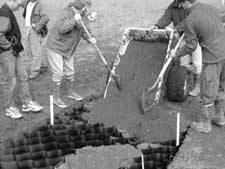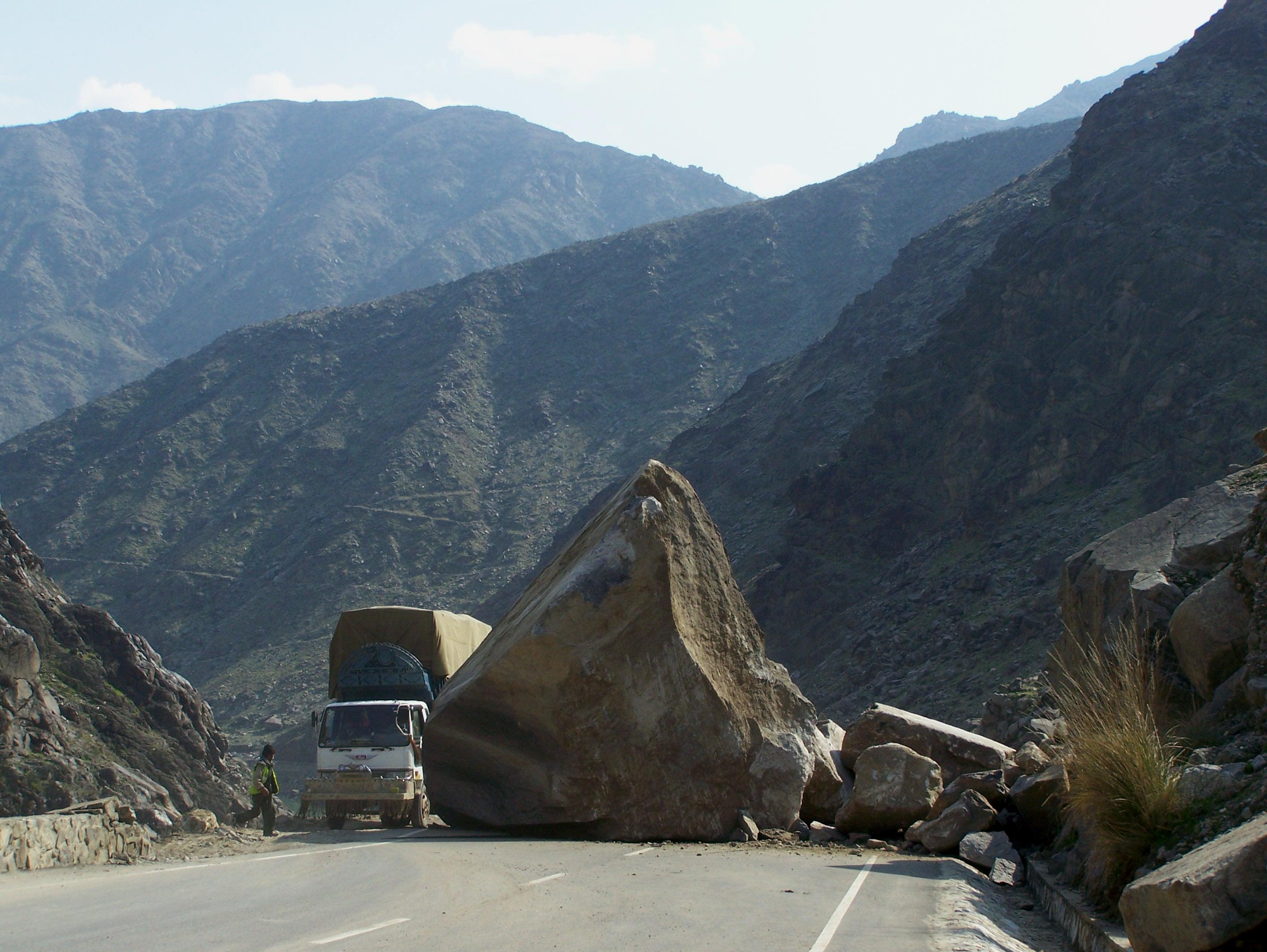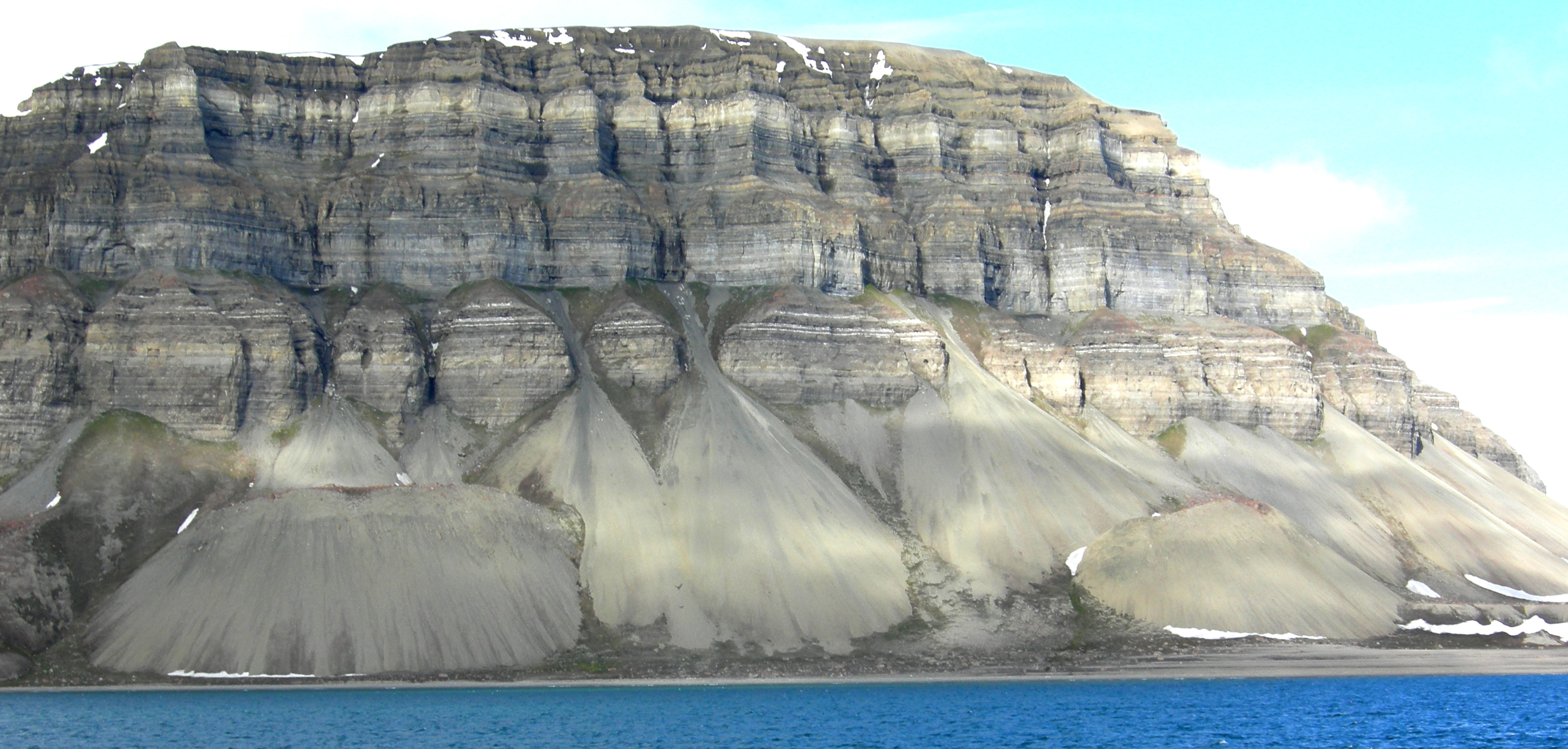|
Cellular Confinement Systems
Cellular confinement systems (CCS)—also known as geocells—are widely used in construction for erosion control, soil stabilization on flat ground and steep slopes, channel protection, and structural reinforcement for load support and earth retention. Typical cellular confinement systems are geosynthetics made with ultrasonically welded high-density polyethylene (HDPE) strips or novel polymeric alloy (NPA)—and expanded on-site to form a honeycomb-like structure—and filled with sand, soil, rock, gravel or concrete. History of cellular confinement Research and development of cellular confinement systems (CCS) began with the U.S. Army Corps of Engineers in 1975 to devise a method for building tactical roads over soft ground. Engineers found that sand-confinement systems performed better than conventional crushed stone sections and they could provide an expedient construction technique for access roads over soft ground, without being adversely affected by wet weather co ... [...More Info...] [...Related Items...] OR: [Wikipedia] [Google] [Baidu] |
Novel Polymeric Alloy
Novel polymeric alloy (NPA) is a polymeric alloy composed of polyolefin and thermoplastic engineering polymer with enhanced engineering properties. NPA was developed for use in geosynthetics. One of the first commercial NPA applications was in the manufacturer of polymeric strips used to form Neoloy® cellular confinement systems (geocells). Novel polymeric alloy was developed as an alternative to high-density polyethylene (HDPE) in geosynthetics. Although HDPE is widely used due to its low cost, ease of manufacturing and flexibility, its relatively high creep, low tensile strength and sensitivity to elevated temperatures limit its use, for example, in long-term, critical geocell applications. Used in the manufacture of geosynthetics, such as cellular confinement system, novel polymeric alloy provides higher tensile strength and stiffness, and are more durable over dynamic loading and under elevated temperatures than those made from HDPE (Han, 2011). The lifespan of NPA ba ... [...More Info...] [...Related Items...] OR: [Wikipedia] [Google] [Baidu] |
Washboarding
Washboarding or corrugation is the formation of periodic, transverse ripples in the surface of gravel and dirt roads. Washboarding occurs in dry, granular road material with repeated traffic, traveling at speeds above . Washboarding creates an uncomfortable ride for the occupants of traversing vehicles and hazardous driving conditions for vehicles that travel too fast to maintain traction and control. Mechanism Washboarding or corrugation of roads comprises a series of ripples, which occur with the passage of wheels rolling over unpaved roads at speeds sufficient to cause bouncing of the wheel on the initially unrippled surface and take on the appearance of a laundry washboard. Most studies of washboarding pertain to granular materials, including sand and gravel. However, other work suggests that the phenomenon may occur in material which has some binding of particles, e.g. clay-like soils. Highway department experts in the mid-1920s were aware that traffic volume and speed ... [...More Info...] [...Related Items...] OR: [Wikipedia] [Google] [Baidu] |
Rockfall
A rockfall or rock-fallWhittow, John (1984). ''Dictionary of Physical Geography''. London: Penguin, 1984. . is a quantity/sheets of rock that has fallen freely from a cliff face. The term is also used for collapse of rock from roof or walls of mine or quarry workings. "A rockfall is a fragment of rock (a block) detached by sliding, toppling, or falling, that falls along a vertical or sub-vertical cliff, proceeds down slope by bouncing and flying along ballistic trajectories or by rolling on talus or debris slopes." Alternatively, a "rockfall is the natural downward motion of a detached block or series of blocks with a small volume involving free falling, bouncing, rolling, and sliding". The mode of failure differs from that of a rockslide. Causal mechanisms Favourable geology and climate are the principal causal mechanisms of rockfall, factors that include intact condition of the rock mass, discontinuities within the rockmass, weathering susceptibility, ground and surface water, ... [...More Info...] [...Related Items...] OR: [Wikipedia] [Google] [Baidu] |
Mass Wasting
Mass wasting, also known as mass movement, is a general term for the movement of rock or soil down slopes under the force of gravity. It differs from other processes of erosion in that the debris transported by mass wasting is not entrained in a moving medium, such as water, wind, or ice. Types of mass wasting include creep, solifluction, rockfalls, debris flows, and landslides, each with its own characteristic features, and taking place over timescales from seconds to hundreds of years. Mass wasting occurs on both terrestrial and submarine slopes, and has been observed on Earth, Mars, Venus, Jupiter's moons Io, and on many other bodies in the Solar System. Subsidence is sometimes regarded as a form of mass wasting. A distinction is then made between mass wasting by subsidence, which involves little horizontal movement, and mass wasting by slope movement. Rapid mass wasting events, such as landslides, can be deadly and destructive. More gradual mass wasting, such as soil cr ... [...More Info...] [...Related Items...] OR: [Wikipedia] [Google] [Baidu] |
Gabion
A gabion (from Italian ''gabbione'' meaning "big cage"; from Italian ''gabbia'' and Latin ''cavea'' meaning "cage") is a cage, cylinder or box filled with rocks, concrete, or sometimes sand and soil for use in civil engineering, road building, military applications and landscaping. For erosion control, caged riprap is used. For dams or in foundation construction, cylindrical metal structures are used. In a military context, earth- or sand-filled gabions are used to protect sappers, infantry, and artillerymen from enemy fire. Leonardo da Vinci designed a type of gabion called a ''Corbeille Leonard'' ("Leonard basket") for the foundations of the San Marco Castle in Milan. Civil engineering The most common civil engineering use of gabions was refined and patented by Gaetano Maccaferri in the late 19th century in Sacerno, Emilia Romagna and used to stabilize shorelines, stream banks or slopes against erosion. Other uses include retaining walls, noise barriers, temporary flood w ... [...More Info...] [...Related Items...] OR: [Wikipedia] [Google] [Baidu] |
Avalanche Control
Avalanche control or avalanche defense activities reduce the hazard avalanches pose to human life, activity, and property."Mitigation and Land Use - Avalanches" , Colorado Geological Survey Avalanche control begins with a risk assessment conducted by surveying for potential avalanche terrain by identifying geographic features such as vegetation patterns, drainages, and seasonal snow distribution that are indicative of avalanches. From the identified avalanche risks, the hazard is assessed by identifying threatened human geographic features such as roads, ski-hills, and buildings. Avalanche control programs address the avalanche hazard by formulating prevention and mitigation plans, which are then executed during the winter season. The prevention and mitigation plans combine extensive snow pack observation wi ... [...More Info...] [...Related Items...] OR: [Wikipedia] [Google] [Baidu] |
International Green Construction Code
The International Green Construction Code (IGCC) is a set of guidelines that aim to improve the sustainability and environmental performance of buildings during their design, construction, and operation. It was introduced by the International Code Council (ICC), a non-profit organization that provides building safety and fire prevention codes for the United States and other countries. It is a model code designed to be mandatory where it’s implemented. The IgCC is the first of its kind, a national green code that builds upon pre-existing codes such as the IBC, IECC and other 'I-Codes' by adding extra green provisions. History The International Code Council (ICC) developed the IgCC in 2009 (Public Version 1.0). Since then, there have been five editions of the code, with the most recent being the 2021 IgCC. The 2018 version of the code was co-developed by the ICC and the American Society of Heating, Refrigeration and AirConditioning Engineers (ASHRAE). Chapter 1 of the code is h ... [...More Info...] [...Related Items...] OR: [Wikipedia] [Google] [Baidu] |
Gravel
Gravel is a loose aggregation of rock fragments. Gravel occurs naturally throughout the world as a result of sedimentary and erosive geologic processes; it is also produced in large quantities commercially as crushed stone. Gravel is classified by particle size range and includes size classes from granule- to boulder-sized fragments. In the Udden-Wentworth scale gravel is categorized into granular gravel () and pebble gravel (). ISO 14688 grades gravels as fine, medium, and coarse, with ranges 2–6.3 mm to 20–63 mm. One cubic metre of gravel typically weighs about 1,800 kg (or a cubic yard weighs about 3,000 lb). Gravel is an important commercial product, with a number of applications. Almost half of all gravel production is used as aggregate for concrete. Much of the rest is used for road construction, either in the road base or as the road surface (with or without asphalt or other binders.) Naturally occurring porous gravel deposits have a ... [...More Info...] [...Related Items...] OR: [Wikipedia] [Google] [Baidu] |
Geomembrane
A geomembrane is very low permeability synthetic membrane liner or barrier used with any geotechnical engineering related material so as to control fluid (liquid or gas) migration in a human-made project, structure, or system. Geomembranes are made from relatively thin continuous polymeric sheets, but they can also be made from the impregnation of geotextiles with asphalt, elastomer or polymer sprays, or as multilayered bitumen geocomposites. Continuous polymer sheet geomembranes are, by far, the most common. Manufacturing The manufacturing of geomembranes begins with the production of the raw materials, which include the polymer resin, and various additives such as antioxidants, plasticizers, fillers, carbon black, and lubricants (as a processing aid). These raw materials (i.e., the "formulation") are then processed into sheets of various widths and thickness by extrusion, calendering, and/or spread coating. Geomembranes dominate the sales of geosynthetic products, at U ... [...More Info...] [...Related Items...] OR: [Wikipedia] [Google] [Baidu] |
Leachates
A leachate is any liquid that, in the course of passing through matter, extracts soluble or suspended solids, or any other component of the material through which it has passed. Leachate is a widely used term in the environmental sciences where it has the specific meaning of a liquid that has dissolved or entrained environmentally harmful substances that may then enter the environment. It is most commonly used in the context of land-filling of putrescible or industrial waste. In the narrow environmental context leachate is therefore any liquid material that drains from land or stockpiled material and contains significantly elevated concentrations of undesirable material derived from the material that it has passed through. Landfill leachate Leachate from a landfill varies widely in composition depending on the age of the landfill and the type of waste that it contains. It usually contains both dissolved and suspended material. The generation of leachate is caused principall ... [...More Info...] [...Related Items...] OR: [Wikipedia] [Google] [Baidu] |
Mechanically Stabilized Earth
Mechanically stabilized earth (MSE or reinforced soil) is soil constructed with artificial reinforcing. It can be used for retaining walls, bridge abutments, seawalls, and dikes. Although the basic principles of MSE have been used throughout history, MSE was developed in its current form in the 1960s. The reinforcing elements used can vary but include steel and geosynthetics. MSE is the term usually used in the US to distinguish it from the trade name "Reinforced Earth". Elsewhere "reinforced soil" is the generally accepted term. Description MSE walls stabilize unstable slopes and retain the soil on steep slopes and under crest loads. The wall face is often of precast, segmental blocks, panels or geocells that can tolerate some differential movement. The walls are infilled with granular soil, with or without reinforcement, while retaining the backfill soil. Reinforced walls utilize horizontal layers typically of geogrids. The reinforced soil mass, along with the facing, forms ... [...More Info...] [...Related Items...] OR: [Wikipedia] [Google] [Baidu] |






